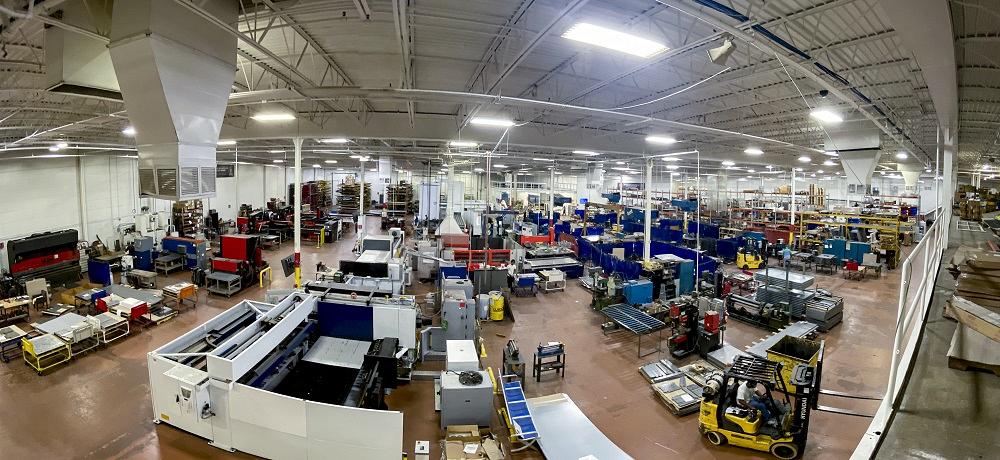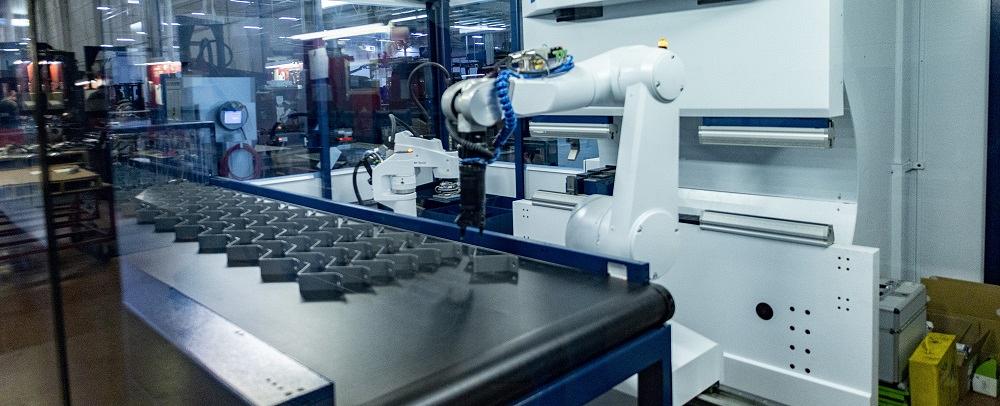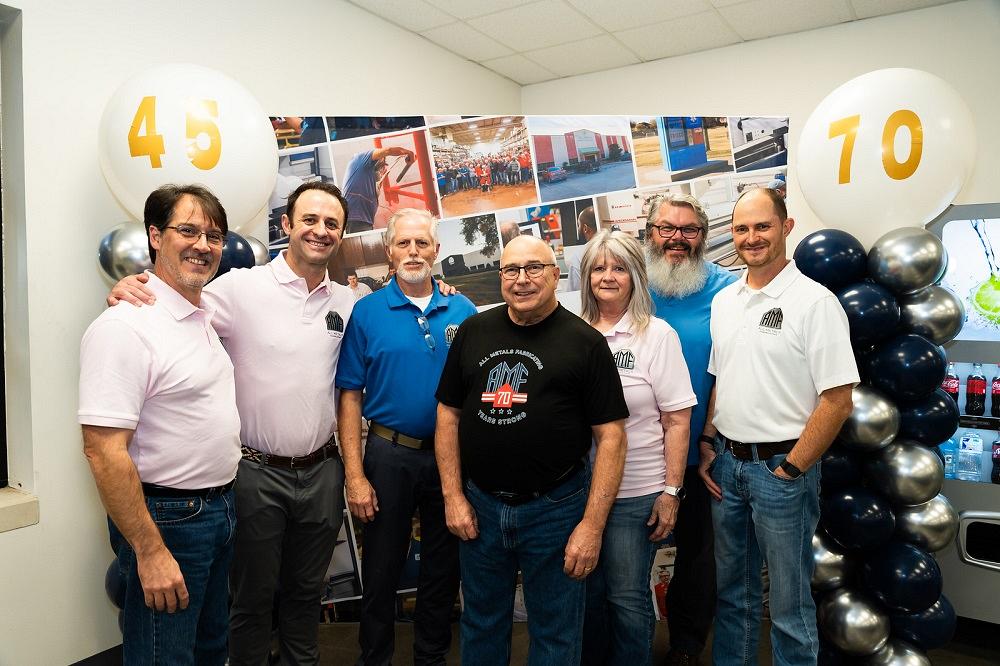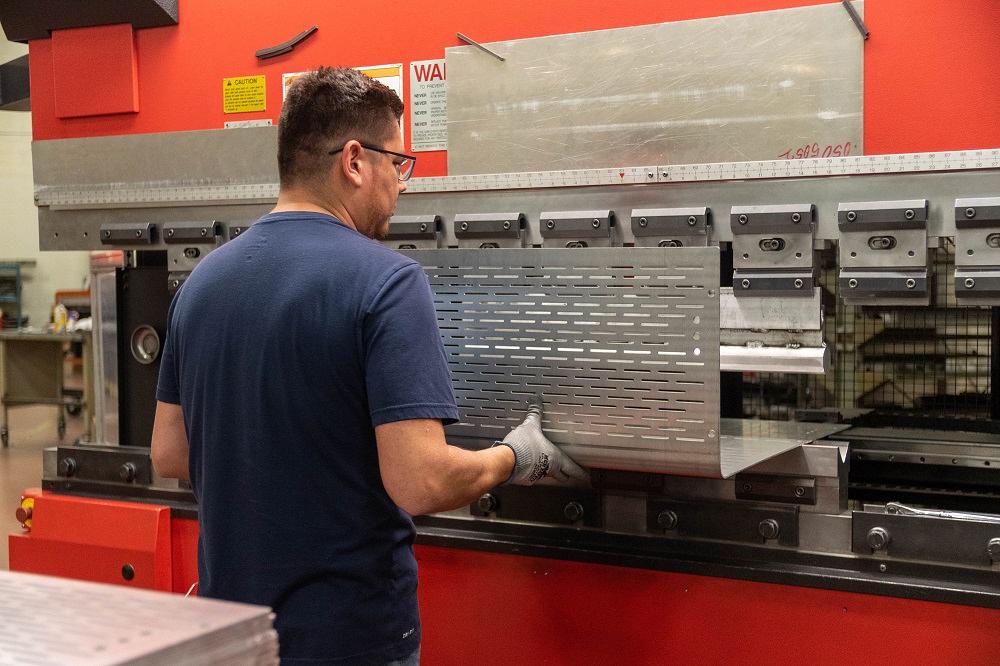Senior Editor
- FMA
- The Fabricator
- FABTECH
- Canadian Metalworking
Categories
- Additive Manufacturing
- Aluminum Welding
- Arc Welding
- Assembly and Joining
- Automation and Robotics
- Bending and Forming
- Consumables
- Cutting and Weld Prep
- Electric Vehicles
- En Español
- Finishing
- Hydroforming
- Laser Cutting
- Laser Welding
- Machining
- Manufacturing Software
- Materials Handling
- Metals/Materials
- Oxyfuel Cutting
- Plasma Cutting
- Power Tools
- Punching and Other Holemaking
- Roll Forming
- Safety
- Sawing
- Shearing
- Shop Management
- Testing and Measuring
- Tube and Pipe Fabrication
- Tube and Pipe Production
- Waterjet Cutting
Industry Directory
Webcasts
Podcasts
FAB 40
Advertise
Subscribe
Account Login
Search
Guiding metal fabrication’s automation transformation
Four foundational factors that summarize All Metals Fabricating’s holistic automated approach
- By Tim Heston
- March 25, 2024
- Article
- Bending and Forming

Texas-based All Metals Fabricating's journey could be summed up in four foundational factors that continue to drive the organization toward its automated future. weiyi zhu / iStock / Getty Images Plus
The shop floor at All Metals Fabricating (AMF) began a transformation in 2016. That’s when the custom metal fabricator started diving deep into automation. It already had robotic welding, but in 2016 it made a big leap forward in laser cutting and punching, investing in towers and load/unload systems. Automated bending came next, including a robotic press brake and a panel bender.
AMF is just getting started. “You see all these integrated, automated cut-to-bend solutions out there, but I’ve seen them mostly in OEMs. I need to see how it works for a custom fabricator like us. We want to prove that out.”
That was Lance Thrailkill, CEO of the Allen, Texas-based, 70-employee operation in the outskirts of Dallas. He and the management team have been leading the automation charge over the past eight years. Walk the floor today, and you see a range of technology from TRUMPF, AMADA, Bystronic, and others. The automation initiative has come a long way and is set to accelerate, with a major addition being built soon to house an automated storage and retrieval system for blanking.
The act of automating isn’t straightforward, especially in custom metal fabrication. As Thrailkill and his team have found, it really takes rethinking the entire operation. Their journey could be summed up in four foundational factors that continue to drive the organization toward its automated future. Without them, AMF probably wouldn’t be as automated as it is now, and the leadership team certainly wouldn’t be accelerating the effort.
1. Automate for the Right Reasons
Thrailkill’s grandfather bought AMF in 1978, and his father joined the fabricator that same year—right in time for the telecom boom. The shop grew rapidly through the 1980s and 1990s before the boom ended in the early 2000s. At that point, AMF moved quickly to diversify, and today the shop serves a range of industries, including a growing slice of the alternative energy sector. Look at the small hut (called the “doghouse”) that houses the electromechanical components of a giant wind turbine, and you might be seeing sheet metal components that came from AMF.
The shop also is laser welding battery modules for an alternative energy customer. Thrailkill pointed to a specialized laser welding robot cell. “We’re laser welding lithium-ion battery cells together with an aluminum busbar on the tabs,” he said. “The design gives you greater battery density … and we’re using traditional sheet metal cutting, bending, and welding to build the battery cabinet. We’ve really tried to position ourselves so we can serve anyone in the sector. And alternative energy has really taken off since the Inflation Reduction Act and all the investment incentives out there.”
Thrailkill added, however, that alternative energy is just one slice of a diverse revenue pie. The last thing he wants is to spur a boom-and-bust, hire-and-layoff cycle. The industry as a whole has enough trouble finding workers, and chronic job insecurity would only add to the problem.
When Thrailkill talked about automation, he mentioned the shortage of skilled workers, but he never described new technology as a replacement for traditional skill. Replacing skilled people with button-pushers is like building a straw house. Sure, it’ll be comfortable enough shelter during calm weather (predictable, less challenging workdays), but the next time a storm comes (unexpected customer demand, machine downtime, etc.), watch out for a tumultuous experience. When Thrailkill described the robotic bending cell and panel bender, he didn’t talk about buying them to reduce the need for skilled brake operators. He instead talked about shop culture, improving work life, and the ability to respond to changes in demand.
“Ultimately, it’s about throughput, job security, and being able to ramp up and down without having to add headcount. It also helps with scheduling. We have much tighter control on where everything is in the shop.”
Thrailkill thought back to the boost in demand in late 2016 and early 2017. “We went from the lowest we had in a while to having our business double within a few months. And we just would never have been able to keep up with it if it weren’t for that automation.”

AMF will be starting the second phase of its automation transformation this year, expanding its existing facility to install an automated storage and retrieval system. Images: All Metals Fabricating Inc.
2. Align Incentives With the Bottom Line
Consider a fabricator that invests in an automated fiber laser cutting machine that boosts throughput to an extraordinary degree. What once took a CO2 laser three shifts now takes the fiber laser less than one. Owners and managers rejoice, but how do employees benefit financially? Here’s where AMF’s bonus system plays a critical role.
“For our people, it’s become a real cultural moment,” Thrailkill said. “We incentivize our people to be as efficient as possible. And when you can give them the best equipment they can have, it instills confidence, develops new skills, and creates pride in what they’re doing.”
To incentivize people to work smarter, not longer, AMF has long tracked job performance through its ERP system. If employees consistently beat the time estimated between clocking in and out of a job, they could increase their bonus.
“We’ve been tracking efficiency for decades,” Thrailkill said, “but we didn’t have the dashboard.”
The dashboard he’s referring to gives operators true machine uptimes—that is, the amount of time the processing heads or tools are contacting sheet metal and making good parts. The Alora platform from ECI connects directly with machines, records the actual setup and production times, and reveals the true “uptime” percentage.
“It was pretty eye-opening,” Thrailkill said. “We thought we’d need a new laser. Then we turned machine monitoring on, and we found we were running at 30% utilization.”
The operation has since improved this significantly, and part of it occurred through scheduling. When practical, the laser now cuts more nests of steel before switching over to aluminum, minimizing the downtime involved with setup. But as Thrailkill explained, that’s just part of the picture. Most of the improvement occurred through small changes here and there (“everyday kaizen,” in lean parlance). They discovered better ways to move and stage material, for instance. After numerous small adjustments, the shop increased utilization at the laser from 30% to almost 70%.
“It’s really just about visibility,” he said. “People see what’s happening and work toward improvement. They’re automatically going to improve significantly, because they now can track themselves.”
Such monitoring requires the right shop culture. At AMF, workers see that low utilization number not as accusatory finger-pointing (why is this machine not running!?) but instead as an opportunity to improve and, not least, enjoy a larger bonus.
3. Look at the Big Picture
An extraordinarily productive automated machine can look like a game-changer, until you find that the long setup needs to be amortized over a long run of parts. Huge batches lead to more work-in-process (WIP), which leads to longer lead times. For custom metal fabrication, that’s not a good sign.
How times have changed.
“Historically, fabricators needed thousands of parts to justify running jobs on an automated bending cell,” Thrailkill said. “Now, if it’s more than 150 parts and each has more than two bends, we try to run it on our automated [TRUMPF] press brake. Once you program it one time, it’s done, and it effectively does its own setup in a couple of minutes.”
This fact has made more automation practical for the custom fab shop. That said, equipment flexibility is just one piece of the puzzle. Automation on the floor helps open capacity, but it can create constraints elsewhere, like quoting, order processing, and programming.
AMF has adopted the Paperless Parts’ software platform to accelerate quoting. And those quotes for new work are scrutinized for their automation potential. Quoting new work, estimators naturally gravitate to the new, faster technology. But what about repeat work, or revisions of previously run jobs? Programmers might look for revisions and just send the job to the shop floor.
“Once a job gets to the floor, it’s difficult to pivot,” Thrailkill said, adding that in these situations the operation now has “three lines of defense.” It starts with estimating, of course. The more estimators think about what kinds of existing jobs could be a good fit for automation (especially in bending), they can incorporate an automation-strategy review when processing orders.
The second line of defense is programming, and the third is the operational leads on the shop floor. If everyone is thinking about not just what’s being processed, but how, then more potential job routings could be uncovered. The more potential routings a particular job has (through the brake, robotic brake, or panel bender), the more flexible shop capacity becomes, and the better chance AMF has of responding quickly to unexpected demand. This moves the focus from local efficiency (how fast a laser cuts or a brake or panel bender bends) to global efficiency (maximizing throughput of the entire operation). For the right parts, a panel bender is much faster than a press brake, but if it’s unavailable due to a bottleneck, an available press brake, even a manual one, would probably get the job done faster.
4. Think Differently
AMF has been implementing automation in multiple phases. The first phase is nearly complete. The second, to take place this year, will involve installing an automated material handling system between blanking and bending.
“Our goal in five years is to have automation in every department,” Thrailkill said, “and we’re already halfway there.”
Subsequent phases will involve a punch/laser combo and a large-format automated bending cell. That punch/laser combo will have automated parts removal and stacking.
“We need to consider how that will affect other areas of our operation, including quoting and scheduling,” Thrailkill said. “It will call for some counterintuitive thinking.”

AMF has invested in an automated press brake (for smaller parts) and a panel bender. It next plans to integrate an automated brake for larger workpieces.
For instance, common quoting practices hinge on machine processing speed, including how many inches per minute (on average) a laser will cut. Blanking with automated part sorting changes the equation, since the machine cycle incorporates both cutting and sorting.
As Thrailkill put it, “Once fab shops get a lot of automation [but without automated part sorting], they shift the labor to shaking out parts. You can run a job all night, but someone has to shake those parts out the next day. So, it will be just a huge advantage to have that part-sorting capability.”
Sorting does require new strategies when it comes to nesting, part orientation, and material yield. Still, such automation makes the sorting function predictable and repeatable—no more rummaging through a pile of cut parts still tabbed into the skeleton. Such predictability can help “smooth out” the inherent variability of manual sorting and related tasks. Incredibly fast cutting is great, until rework rises due to lost or damaged parts. This again relates to thinking globally (enterprise-wide) versus locally (number of inches or strokes per minute; maximum material yield) when it comes to efficiency.
Thinking globally really is what AMF’s automation transformation has been all about. From quoting to programming and production planning, optimizing it all requires big-picture thinking. After all, jobs still spend most of their time in between operations as WIP. The more predictable those operations become—from initial loading until parts are stacked and ready for the next operation—the shorter that “in between” time needs to be. Quick response and dramatic boosts in flexible capacity will soon follow.
About the Author

Tim Heston
2135 Point Blvd
Elgin, IL 60123
815-381-1314
Tim Heston, The Fabricator's senior editor, has covered the metal fabrication industry since 1998, starting his career at the American Welding Society's Welding Journal. Since then he has covered the full range of metal fabrication processes, from stamping, bending, and cutting to grinding and polishing. He joined The Fabricator's staff in October 2007.
Related Companies
subscribe now

The Fabricator is North America's leading magazine for the metal forming and fabricating industry. The magazine delivers the news, technical articles, and case histories that enable fabricators to do their jobs more efficiently. The Fabricator has served the industry since 1970.
start your free subscription- Stay connected from anywhere

Easily access valuable industry resources now with full access to the digital edition of The Fabricator.

Easily access valuable industry resources now with full access to the digital edition of The Welder.

Easily access valuable industry resources now with full access to the digital edition of The Tube and Pipe Journal.
- Podcasting
- Podcast:
- The Fabricator Podcast
- Published:
- 04/16/2024
- Running Time:
- 63:29
In this episode of The Fabricator Podcast, Caleb Chamberlain, co-founder and CEO of OSH Cut, discusses his company’s...
- Trending Articles
Tips for creating sheet metal tubes with perforations

Are two heads better than one in fiber laser cutting?

Supporting the metal fabricating industry through FMA

JM Steel triples capacity for solar energy projects at Pennsylvania facility

Omco Solar opens second Alabama manufacturing facility

- Industry Events
16th Annual Safety Conference
- April 30 - May 1, 2024
- Elgin,
Pipe and Tube Conference
- May 21 - 22, 2024
- Omaha, NE
World-Class Roll Forming Workshop
- June 5 - 6, 2024
- Louisville, KY
Advanced Laser Application Workshop
- June 25 - 27, 2024
- Novi, MI




























